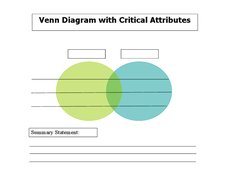Curated OER
Where are the Electrons?
In this electrons worksheet, students complete a graphic organizer to show the pattern of the principal energy levels, number of orbitals, and electrons in each sublevel of atoms.
Curated OER
Acid, Base, or Salt?
In this acids and bases worksheet, high schoolers read about the differences between acids and bases and then complete a table comparing the characteristics of both. Then students determine if the given statements describe an acid, base,...
Curated OER
Recognizing Polar Molecules
In this polar molecules instructional activity, students complete a graphic organizer by writing in the bond type, electron dot diagram, and the type of compound for the chemical compounds given.
Curated OER
Give One - Get One
In this give one, get one graphic organizer worksheet, students explore a topic of their choice as they record up to 12 details pertaining to it.
Curated OER
Cornell Note Taker
In this note taking worksheet, students use the Cornell method for note taking. Students write down their topic, their main points, and evidence or details to support the main points.
Curated OER
Concrete Detail and Commentary
In this writing skills worksheet, students practice writing with facts or quotes from a text by following the graphic organizer format. Students write the concrete detail and then list two commentaries for their facts or quotes.
Curated OER
Vocabulary Cards
In this vocabulary activity worksheet, students complete the graphic organizer that has them list the word, its part of speech and definition. Students then make a drawing or symbol for the word and write a sentence with the word.
Curated OER
Inverted Pyramid of Ideas
In this graphic organizer worksheet, students use the inverted pyramid to help them organize ideas for a topic. Students write their ideas in the provided space.
Curated OER
2 Column Notes
In this taking notes worksheet, students use the 2 column graphic organizer to help them take notes while reading. Students write the title and the two columns to organize their thoughts and quotes from the text.
Curated OER
3 Column Notes
In this note taking worksheet, students complete the 3 column note graphic organizer to help them understand a text and organize their notes about the text.
Curated OER
Process Grid
In this graphic organizer worksheet, students complete the chart for effects, descriptions, results or outcomes, and other facts for the process grid.
Curated OER
KWL Chart
In this graphic organizer worksheet, students complete a KWL chart with information about what they know, what they want to know, and what they have learned about an assigned topic.
Curated OER
Types of Weathering
In this weathering worksheet, students compare mechanical and chemical weathering and give an example of each type of weathering listed. This worksheet has 2 graphic organizers.
Curated OER
Element Symbols
In this elements learning exercise, students complete a graphic organizer by writing in the correct symbol for the 12 elements given.
Curated OER
Lab Safety Rules
In this lab safety rules worksheet, students are given fourteen rules for safety in the laboratory. They include wearing safety goggles, wearing proper clothing, not horsing around in the lab and not forcing tubing into stoppers.
Curated OER
Observing Weather Chart
In this weather worksheet, students are given a chart to complete when observing the weather. Included is the date, the temperature, the pressure, the humidity, the wind speed and direction, the visibility, the cloud type and cover, the...
Curated OER
Elements
In this elements worksheet, students are given ten elements, their Latin, Greek or Egyptian root, the meaning of the root and the element's symbol.
Curated OER
Event Graphic Organizer
For this event graphic organizer worksheet, students identify an event, record details, list prior knowledge, make inferences, and make a conclusion.
Curated OER
Episode Graphic Organizer
In this episode graphic organizer, students organize a large body of information about specific events. This information includes; time and place, specific people or events, specific duration, event's particular cause and effect.
Curated OER
Episodic Summary: Problem Solving
In this episodic summary graphic organizer worksheet, students practice their problem solving skills as they chart an event by identifying the problem, sequence of events, setting, and major players.
Curated OER
Venn Diagram with Critical Attributes
In this Venn diagram graphic organizer worksheet, students compare and contrast an item using the overlapping diagram. Students also list critical attributes in the space provided.
Curated OER
Organizer for Fact Finding and Inferring from Visual Sources
In this graphic organizer fact finding and inferences instructional activity, students record details that they can see and prove as well as those that are inferences.
Curated OER
Event Graphic Organizer
In this event graphic organizer worksheet, students identify an event, record details, list prior knowledge, make inferences, and make a conclusion.
Curated OER
Social Studies Strategies Emotional Timeline
In this social studies strategies worksheet, students record events in a story and chart them on a line graph according to how good or bad they are in the life of the main character.

























